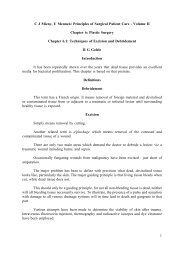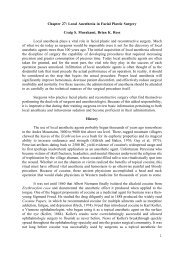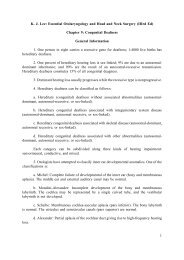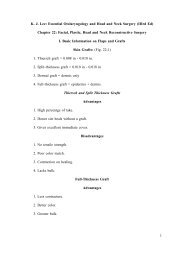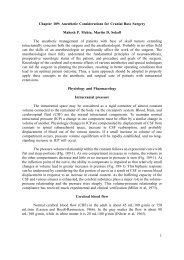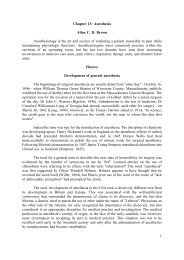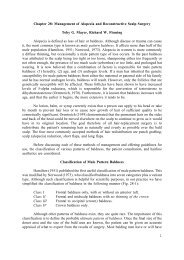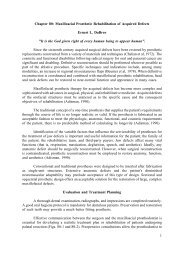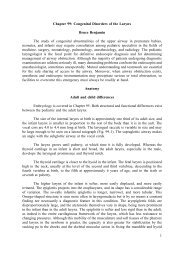1 Chapter 8: Skin Flap Physiology George S. Goding ... - Famona Site
1 Chapter 8: Skin Flap Physiology George S. Goding ... - Famona Site
1 Chapter 8: Skin Flap Physiology George S. Goding ... - Famona Site
Create successful ePaper yourself
Turn your PDF publications into a flip-book with our unique Google optimized e-Paper software.
microvasculature are similar to PGE 1 . Prostacyclin (PGI 2 ) is a vasodilating agent and inhibitor<br />
of platelet aggregation that is derived from PGH 2 through the action of prostacyclin synthase.<br />
In the skin PGI 2 is primarily produced in the endothelial cells of blood vessels (Hauben and<br />
Aijlstra, 1984; Kaley et al, 1985). Prostacyclin is metabolized to 6-keto-PGF 1a .<br />
Thromboxane synthetase converts PGH 2 into thromboxane A 2 (TxA 2 ) and is primarily<br />
located in the platelets. Its effects include vessel constriction and promotion of platelet<br />
aggregation (Kay and Green, 1986). TxA 2 is unstable and rapidly converted into thromboxane<br />
B 2 (TxB 2 ). Prostaglandin F 2a (PGF 2a ) is derived from PGH 2 by a reductase reaction. PGF 2a<br />
does not appear to influence blood flow in segmental or perforating arteries but does result<br />
in venoconstriction at these levels. A marked increase in resistance is seen in cutaneous<br />
arteries, arterioles, and venules in the presence of PGF 2a (Nakano, 1973).<br />
The synthesis of prostaglandins and thromboxane can be altered by pharmacologic<br />
manipulation. The action of phospholipase A 2 can be inhibited by drugs that reduce the<br />
availability of Ca ++ . Glucocorticoids also affect phospholipase A 2 activity by inducing the<br />
synthesis of a protein that inhibits the enzyme (Campbell, 1990). Aspirin and other<br />
nonsteroidal antiinflammatory medications interfere with the cyclooxygenase enzyme, thus<br />
inhibiting the synthesis of PGH 2 .<br />
Recent studies have provided further insight into the activity of prostaglandins in<br />
ischemic flaps. Prostacyclin levels were found to increase 4 days after elevation of a porcine<br />
flank flap, to peak on day 7, and then to decrease up to postoperative day 21 (Hauben and<br />
Aijlstra, 1984). Elevation of a bipedicled rat dorsal flap resulted in elevated levels of PGE 2 ,<br />
PGF 2a , and TxB 2 , with a return to near-normal levels by day 7. Conversion to a single-pedicle<br />
flap ("delay") resulted in a blunted production of thromboxane and an elevated PGE 2 that<br />
lasted for at least 7 days. Elevation of an acute flap showed an elevation of PGE 2 , PGF 2a , and<br />
TxB 2 that was greater and more prolonged than seen with surgical delay (Murphy et al, 1985).<br />
Blood samples drawn from a rat hind limb rendered ischemic for 5 hours showed<br />
marked elevation of TxB 2 , 6-ketoprostaglandin F 2a (a metabolite of PGI 2 ), and PGE 2 (Feng<br />
et al, 1988). A difference between tissue tolerating reflow and tissue demonstrating no reflow<br />
was noted. Injection of 2% formic acid into the rat dorsal flap resulted in an increase of TxA 2<br />
and a small increase of PGE 2 . After flap elevation the flaps treated with formic acid<br />
demonstrated a decrease in TxA 2 and an increase in PGE 2 (Lawrence et al, 1984). It is clear<br />
from these studies that prostaglandins play a role in the inflammatory response after flap<br />
surgery. Whether these changes in prostaglandin levels represent a cause or a side effect of<br />
the observed phenomenon remains to be demonstrated.<br />
Reperfusion (free radicals)<br />
Return of blood flow to an ischemic flap under the influence of excess<br />
vasoconstriction due to excessive release of norepinephrine occurs in approximately 12 hours.<br />
With norepinephrine depletion and continued inflammatory response, blood flow can reach<br />
a maximum at 24 hours in the rat and pig models (Pang et al, 1986c; Sasaki and Pang, 1980).<br />
When oxygen becomes available with reperfusion, an additional menace to flap survival is<br />
produced, the free radical. This byproduct of reperfusion can cause damage at both the<br />
cellular and subcellular levels, contributing to postischemic tissue necrosis.<br />
8




